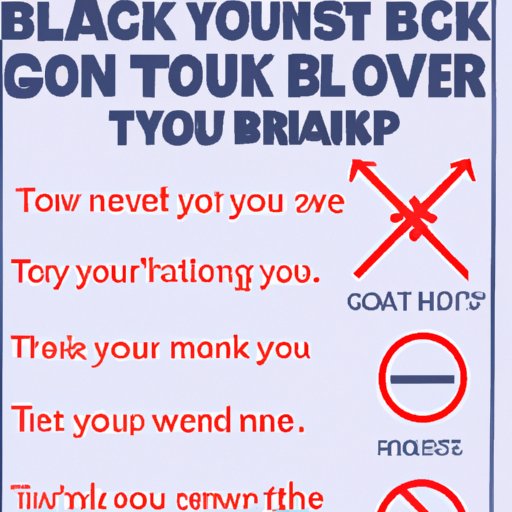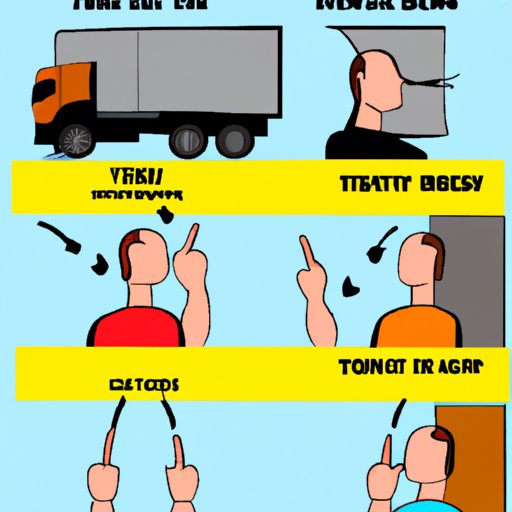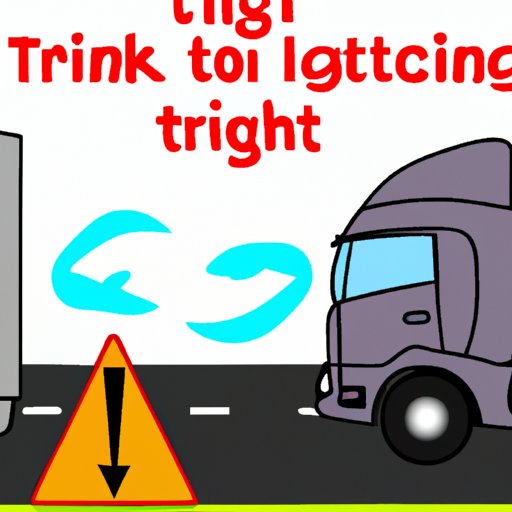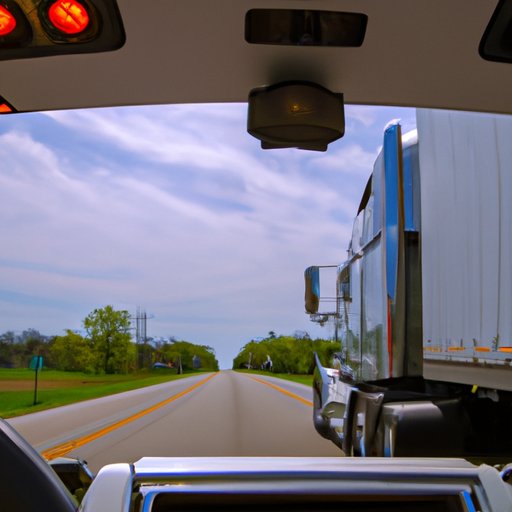Introduction
Driving on the highway can be intimidating, especially when you’re driving behind a large truck. Trucks are much larger than regular cars and can be difficult to maneuver around. Additionally, many drivers are unaware of the specific safety precautions that need to be taken when driving behind a large truck. In this article, we will discuss the dangers of driving behind a large truck and provide tips and strategies for safely sharing the road.

Tips for Safely Driving Behind Large Trucks
When driving behind a large truck, it is important to be aware of the potential danger that comes with it. Here are some tips for staying safe on the road:
Be aware of blind spots
Large trucks have several blind spots that can make it difficult for the driver to see other vehicles around them. According to the Federal Motor Carrier Safety Administration (FMCSA), “Truck drivers have large blind spots on all four sides of their vehicles. If you cannot see the truck driver in his or her side mirrors, then the truck driver likely cannot see you.” It is important to be aware of these blind spots and to avoid driving in them whenever possible.
Keep a safe distance from the truck
When travelling behind a large truck, it is important to maintain a safe distance between your vehicle and the truck. The FMCSA recommends keeping a minimum of 20 feet between your vehicle and the truck. This will give you enough time to react if the truck driver needs to stop suddenly.
Pay attention to the signals of the truck driver
It is also important to pay attention to the signals of the truck driver. Truck drivers use turn signals, brake lights, and hand signals to communicate with other drivers on the road. Understanding these signals can help you stay safe and anticipate the truck driver’s movements.
Avoiding Blind Spots When Travelling Behind Large Trucks
In order to avoid the blind spots of a large truck, it is important to understand the size and shape of the truck. According to the National Highway Traffic Safety Administration (NHTSA), “The average commercial truck is approximately 70 feet long, 8.5 feet wide, and 13.5 feet tall.” Knowing the size and shape of the truck can help you stay out of its blind spot by keeping a safe distance.
In addition to understanding the size and shape of the truck, it is important to learn the signs that indicate when a truck is entering or exiting a lane. Many truck drivers use their turn signals to signal when they are entering or exiting a lane. Paying attention to these signals can help you anticipate the truck driver’s movements and avoid any potential collisions.

How to Read the Signals of a Truck Driver
In order to safely share the road with a large truck, it is important to understand how to read the signals of the truck driver. Truck drivers use turn signals, brake lights, and hand signals to communicate with other drivers on the road. Learning how to interpret these signals can help you anticipate the truck driver’s movements and stay safe on the road.
Truck drivers use their turn signals to indicate when they are entering or exiting a lane. They also use their brake lights to signal when they are slowing down or stopping. Additionally, truck drivers often use hand signals to communicate with other drivers. Common hand signals used by truck drivers include pointing to the left or right to indicate which direction they are turning.
What to Do When Caught in a Truck’s Slipstream
When driving behind a large truck, it is possible to get caught in the truck’s slipstream. This can happen when there is not enough distance between your vehicle and the truck. If you find yourself caught in a truck’s slipstream, here are some tips for staying safe:
Slow down
If you find yourself caught in a truck’s slipstream, the first thing you should do is slow down. Slowing down will reduce the pressure of the slipstream and allow you to escape more easily.
Move away from the slipstream
Once you have slowed down, move away from the slipstream as quickly as possible. Moving away from the slipstream will allow you to regain control of your vehicle.
Avoid sudden movements
When moving away from the slipstream, it is important to avoid making any sudden movements. Sudden movements can cause you to lose control of your vehicle and put you at risk of an accident.

Strategies for Keeping a Safe Distance from Big Trucks
Keeping a safe distance from large trucks is essential for staying safe on the road. Here are some strategies for maintaining a safe distance from big trucks:
Leave plenty of room between you and the truck
When driving behind a large truck, it is important to leave plenty of room between you and the truck. The FMCSA recommends leaving a minimum of 20 feet between your vehicle and the truck. This will give you enough time to react if the truck driver needs to stop suddenly.
Increase your following distance when the road is wet or slippery
It is also important to increase your following distance when the roads are wet or slippery. These conditions can reduce the amount of traction your vehicle has, making it more difficult to stop quickly if necessary.
Avoid trying to pass a truck on the highway
When travelling behind a large truck, it is best to avoid trying to pass it on the highway. Trucks take up more space on the road than regular cars and can make it difficult to pass safely.
Rules for Passing and Merging with Large Trucks on the Road
When passing or merging with a large truck on the road, it is important to follow the rules of the road. Here are some tips for passing and merging safely with large trucks:
Understand the rules of the road
Before passing or merging with a large truck, it is important to understand the rules of the road. Make sure you know which lanes you are allowed to use and what the speed limit is in the area.
Allow plenty of time and space when passing or merging
When passing or merging with a large truck, it is important to allow plenty of time and space. Make sure you give the truck plenty of room to maneuver and that you are not putting yourself or other drivers at risk.
Make sure to use your turn signals when merging or turning
It is also important to use your turn signals when merging or turning. This will let the truck driver know your intentions and allow them to adjust accordingly.
Conclusion
Driving behind a large truck can be intimidating, but it doesn’t have to be. By understanding the dangers of driving behind a large truck and following the safety tips outlined in this article, you can safely share the road with large trucks. Remember to be aware of blind spots, keep a safe distance, pay attention to the signals of the truck driver, avoid getting caught in a truck’s slipstream, increase your following distance when the roads are wet or slippery, and follow the rules of the road when passing or merging.
(Note: Is this article not meeting your expectations? Do you have knowledge or insights to share? Unlock new opportunities and expand your reach by joining our authors team. Click Registration to join us and share your expertise with our readers.)
